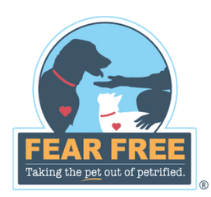|
As a Fear Free practice, we want to help you create a healthy bond with your pet through
supporting not only their physical needs but their emotional needs as well.

Recognizing Body Language in Dogs
We’ve all been there, asking our dog “What’s wrong? Just tell me!”. As much as we all wish they could, our pets can’t tell us how they’re feeling. It is important that we tune into the ways they can communicate with us!
Trembling, growling, and running away are all signs of fear, anxiety, or stress. It’s not always so clear when a dog is in distress. Sometimes their discomfort starts with signs as small as their tail lowering, licking their lips, yawning, or turning their head away. Recognizing these early signs of stress allow us to modify the situation to encourage a more comfortable experience for us and our pets. Being aware of relaxed signs from your dog is important too! Some of these signs are soft eyes, relaxed ears and sweeping tail wags.



Eyes, Ears, Mouth, and Tail
A dog’s eyes, ears, mouth, and tail can be an easy way to begin recognizing your dog's body language:
|
Neutral/Relaxed
|
Beginning Signs of Stress
|
|
EYES
|
Soft eyes/brows, looking at you, normal or some pupil dilation
|
Tense brow, looking away from you, dilated pupils
|
|
EARS
|
Neutral, perked ears
|
Ears back or to the sides
|
|
MOUTH
|
Loose lips/tongue
|
Lip licking, panting, tight lips
|
|
TAIL
|
Slow back and forth sweeping wags, mid-height
|
Low or tucked tail
|

Speaking in a Dog’s Language
Being aware of a human's body language can go a long way with a dog in a stressful situation. If you see us doing any of the following things during your pet’s appointment, it is because we are trying to respect your dog’s boundaries and create a positive environment for them to remember next time they come in.
We may crouch low to the ground, turn sideways from your dog, give them treats and avoid eye contact. As natural as it is to look directly into the eyes of a person, to a dog this can be intimidating. Instead, we may be looking at their ears or away from them; this can be an easier way for us to encourage your dog to approach us. When petting a dog that is scared, we may choose to reach for their chest or shoulder instead of their ears or face. A strange hand coming towards a dog from overhead can be scary or overwhelming.

Calming Aids in Our Hospital
If your dog is scared to visit the vet, they are not alone! To try and create a positive environment for your dog, they will be greeted with a bandana with calming pheromones. These pheromones are also plugged into the outlets of each room. During their visit we will offer treats to your dog (or their own special treats you may bring!) to create happy thoughts and memories of our hospital and their exam. We are always here to answer any questions about fear, anxiety, and stress and hope we can help make your dog’s visit as positive as possible!

For more information about non-verbal communication between dogs and humans, visit https://www.fearfreehappyhomes.com/?s=body+language

|